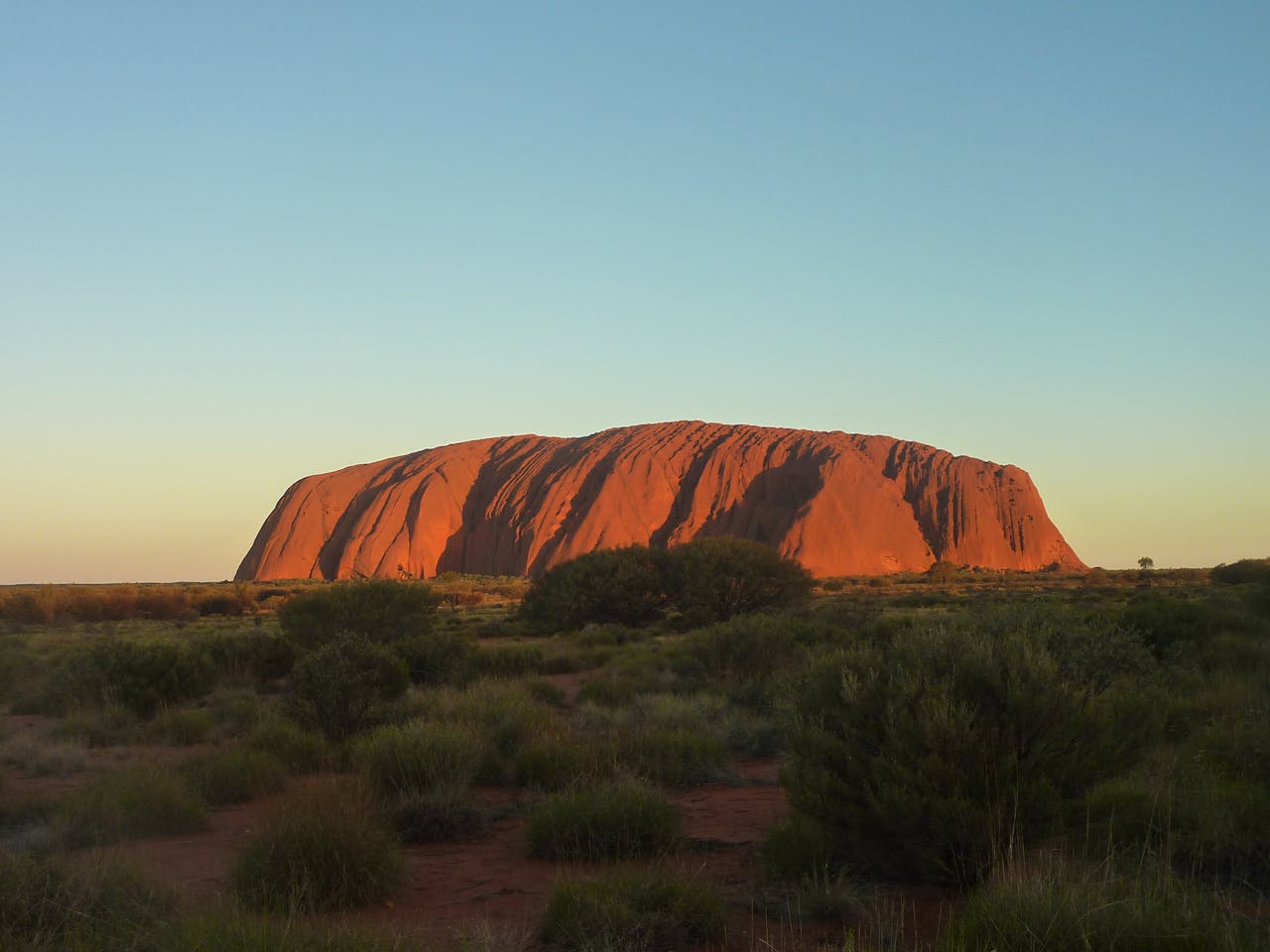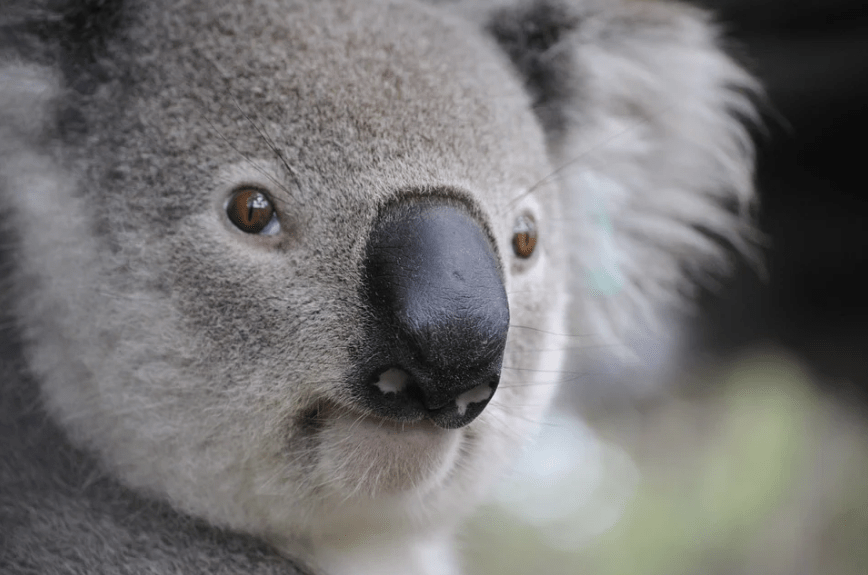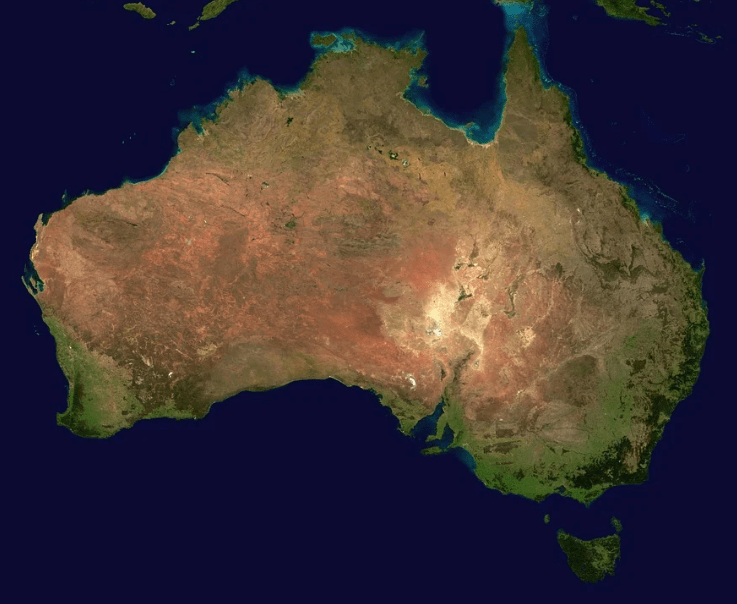What Continent Is Australia In? Geography of the Land Down Under
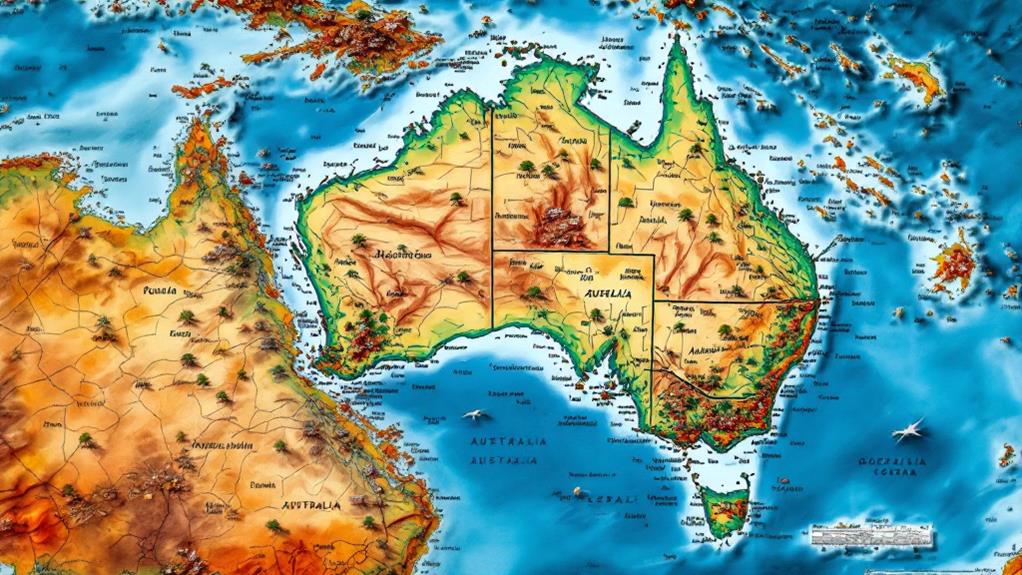
Australia is its own continent, resting entirely in the Southern Hemisphere, aptly earning the nickname "Land Down Under." It's surrounded by the Indian, Pacific, and Southern Oceans, giving it a unique geographic identity. The continent's vast landmass supports diverse ecosystems ranging from arid deserts to lush rainforests, with an impressive 80% of species being endemic. As one of the world's 17 megadiverse countries, Australia holds significant ecological and cultural richness. Its landscapes are shaped by both ancient indigenous heritage and modern developments. There's more to explore about its geographical wonders and cultural foundations beyond just its location.
Geographic Location and Boundaries
Australia's geographic location is unique, as it's the only continent entirely situated in the Southern Hemisphere, earning it the moniker "Land Down Under." Surrounded by the vast Indian, Pacific, and Southern Oceans, Australia's isolation is both its charm and its defining feature. This seclusion has crafted a land rich with unique wildlife and diverse ecosystems. Its geographical boundaries are outlined by shallow seas such as the Arafura Sea, Torres Strait, and Bass Strait. These natural divisions not only separate Australia from nearby landmasses but also contribute to its distinct ecological identity.
The Indian Ocean lies to the west, providing a vast maritime boundary that influences Australia's climate and weather patterns. To the east, the Pacific Ocean stretches beyond the horizon, while the Southern Ocean defines its southern edge. These oceans serve as barriers and protectors, encouraging the development of species found nowhere else on Earth. You'll find Australia's landmass spans approximately 8,600,000 km², making it the seventh-largest continent globally. This expansive terrain hosts a remarkable variety of habitats, from arid deserts to lush rainforests, each home to flora and fauna that reflect Australia's unique position in the Southern Hemisphere.
Historical Overview of Australia
The ancient landscapes of Australia whisper stories of its rich history, stretching back at least 50,000 years with Indigenous Australians as its primary inhabitants. Evidence suggests human presence might even date back 65,000 years. These early communities are intricately tied to the geography of the continent, thriving in distinct environments from arid deserts to lush rainforests. Their long-standing connection to the land highlights their role as the original custodians of Australia.
Historically, the continent's name was linked to the mythical Terra Australis Incognita, a concept from medieval geography. This mythical land, believed to balance the northern continents, sparked curiosity among European adventurers. In 1606, Willem Janszoon became the initial documented European to land on Australian shores, initiating a wave of examination and eventual settlement.
During the Pleistocene ice epoch, lower sea levels connected Australia to New Guinea and other landmasses, forming a supercontinent known as Sahul. This geographical feature facilitated the movement and interaction of numerous peoples, including those of Melanesian descent. Over millennia, these interactions contributed to the rich cultural and linguistic diversity seen in Australia today. Understanding these historical layers amplifies your appreciation of Australia's unique place in the world.
Cultural Diversity and Heritage
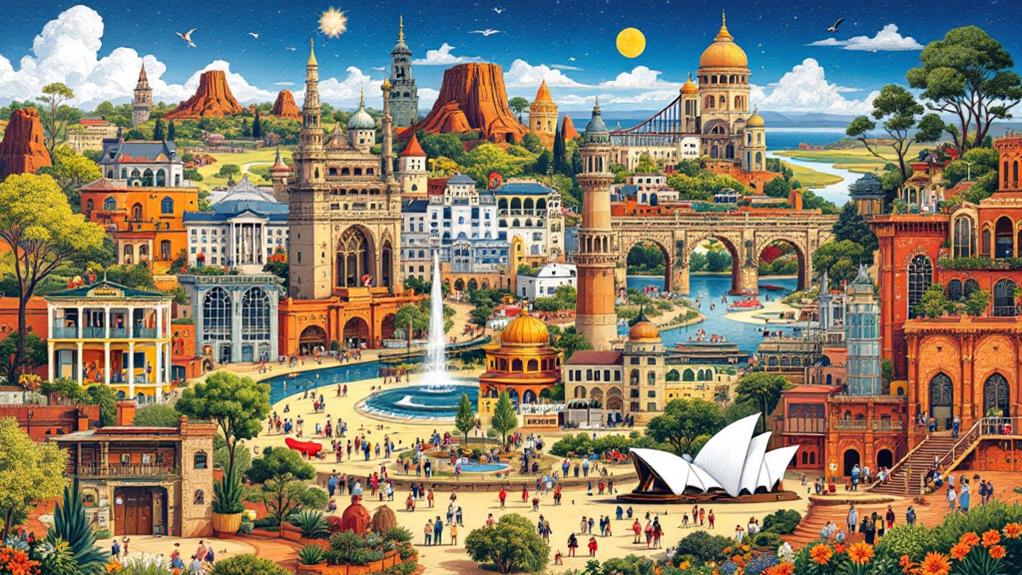
Often celebrated for its lively tapestry of cultures, Australia stands as a tribute to both ancient traditions and modern multiculturalism. You're stepping into a land where cultural diversity isn't just a buzzword—it's a way of life. Aboriginal Australians and Torres Strait Islanders have nurtured a rich Indigenous heritage, with cultures and languages flourishing for over 50,000 years. This deep connection to the land is beautifully expressed through the Dreamtime, a storytelling tradition that paints the spiritual landscapes of their beliefs.
Living in a multicultural society, you'll find Australia's cultural landscape dynamic and diverse. Immigration has played a key role in shaping this, bringing influences from around the world. Just north of Australia, Papua New Guinea adds to the region's rich tapestry, boasting over 800 distinct languages. It's a reminder of the linguistic and cultural wealth that surrounds you.
In Australia, cultural celebrations like NAIDOC Week honor the history and achievements of Indigenous Australians. Through art, music, and festivals, you'll experience the profound respect for both ancient traditions and the harmonious blend of global cultures. This is a place where the past and present coexist, offering a unique cultural narrative for you to investigate.
Unique Ecosystems and Wildlife
As you welcome the rich cultural tapestries of Australia, you'll also find yourself amidst a world of extraordinary ecosystems and wildlife. Australia's unique ecosystems, from arid deserts to lush tropical rainforests, are home to an incredible array of biodiversity. With approximately 80% of its flora and fauna being endemic, species like kangaroos and koalas thrive here, and you won't find them anywhere else. The Great Barrier Reef, the world's largest coral reef system, stretches over 2,300 kilometers (1,430 miles) along the northeastern coast, hosting an unmatched diversity of marine life.
However, Australia's biodiversity faces challenges from climate change, habitat loss, and invasive species. This has sparked significant conservation efforts aimed at preserving these irreplaceable natural gems. By understanding these challenges, you can appreciate why conservation is vital for maintaining Australia's status as one of the 17 megadiverse countries, housing around 7% of the world's total biodiversity.
Here's a quick guide to Australia's natural wonders:
- Great Barrier Reef: An underwater paradise teeming with life.
- Arid Deserts: Home to resilient endemic species.
- Tropical Rainforests: Rich havens of biodiversity.
Economic Landscape and Development
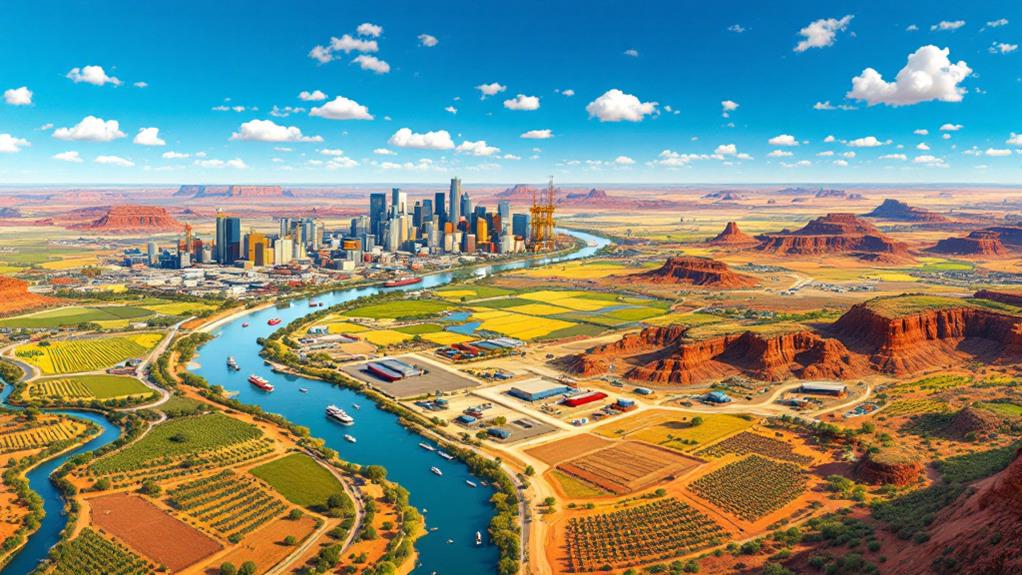
Australia boasts a robust and diverse economy, ranking as the 14th largest globally. With a high human development index, it stands second worldwide. The economy thrives on key sectors like agriculture, mining, tourism, and services. These sectors considerably contribute to the country's GDP, reflecting its economic strength. Urbanization plays a crucial role, with more than 80% of the population living in urban areas, driving concentrated economic growth in major cities.
The agricultural sector supports not only the domestic market but also positions Australia as a crucial player in global food supply. Mining is another powerhouse, as the nation is a leading exporter of natural resources such as iron ore and coal. These exports are fundamental for trade relations and economic development. Tourism adds another layer, attracting millions annually and showcasing Australia's unique landscapes and cultural diversity.
Immigration improves the economy further, bringing cultural diversity and bolstering Australia's status as the 9th largest economy regarding purchasing power parity. Trade remains a cornerstone, with natural resources paving the way for strong economic ties internationally. This diverse economic landscape guarantees Australia's continued growth and prosperity.
Political Structure and Governance
Australia's political landscape is defined by its federal parliamentary democracy, a system that combines a constitutional monarchy with democratic governance. As you investigate Australia's political structure, you'll find it comprises six states and two territories, each with its own government. The capital city, Canberra, located in the Australian Capital Territory, serves as the political hub, where key decisions and policies are crafted.
In Australia's federal parliamentary democracy, the Australian Parliament plays an essential role. It's bicameral, consisting of two houses:
- House of Representatives: Members are elected directly by the public, representing diverse constituencies across the country. They play a significant role in forming the government and shaping legislation.
- Senate: This house provides representation for each state and territory, ensuring a balance of power and interests within the federation.
- Governor-General: As the representative of the British monarch, this role underscores Australia's constitutional monarchy, performing ceremonial duties and upholding the rule of law.
Terminology and Colloquial Expressions
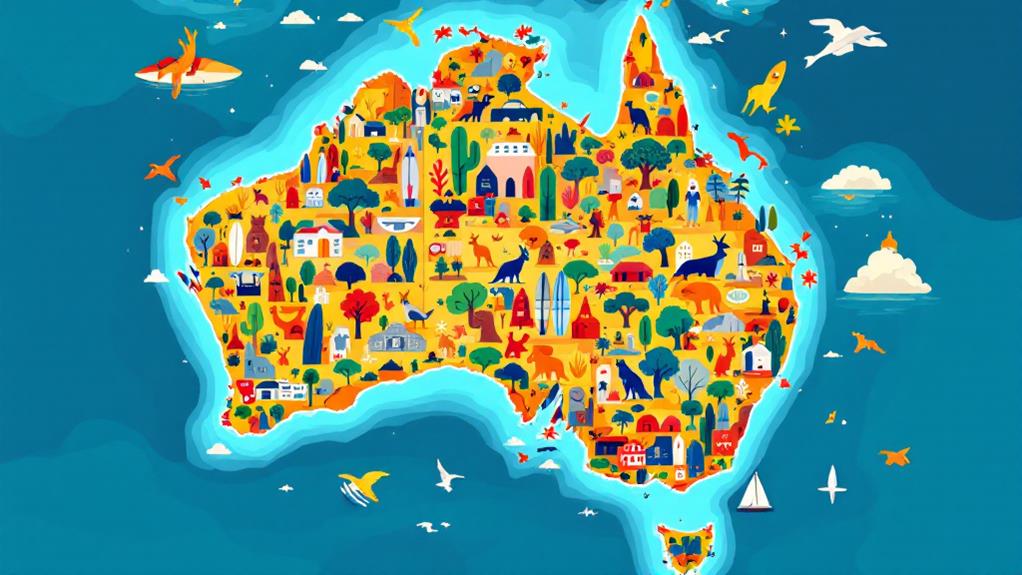
While investigating Australia's political structure, it's fascinating to observe that its unique geographic and cultural elements have also shaped a rich tapestry of terminology and colloquial expressions. One of the most iconic terms is "Down Under," which refers to Australia's position in the Southern Hemisphere. This phrase, originating in the late 19th century, reflects the country's distinctive geography and has become a symbol of national pride. Over time, "Down Under" gained momentum through diverse media and cultural references, especially the Men at Work song, which helped cement its place in popular culture.
Australia is also affectionately known as "Oz" or "the Land of Oz." These terms further emphasize its uniqueness and are accepted both locally and internationally. The abbreviation "Oz" cleverly plays on the phonetic sound of "Aus" in Australia, adding a fanciful touch to the country's identity. These colloquial expressions are more than just names; they capture the essence of Australia's lively culture and its distinctive place in the world. As you explore this land's geography and cultural references, you'll find that these terms paint a vivid picture of a country proud of its heritage and identity.
Environmental Challenges and Conservation
Amidst its stunning landscapes and rich biodiversity, Australia grapples with significant environmental challenges that threaten its natural heritage. Climate change has intensified droughts, bushfires, and extreme weather events, putting immense pressure on the country's ecosystems. Habitat loss from urbanization and agricultural expansion further jeopardizes Australia's unique wildlife, with over 1,800 species facing the risk of extinction. The Great Barrier Reef, a UNESCO World Heritage site, suffers from coral bleaching and degradation due to rising sea temperatures and ocean acidification, endangering marine biodiversity.
To address these challenges, you can focus on several key conservation efforts:
- Protected Areas: Approximately 19% of Australia's landmass is designated as national parks and reserves, providing vital protection for biodiversity and endangered species.
- Habitat Restoration: Initiatives are underway to restore habitats and mitigate habitat loss. These efforts aim to create safe environments for wildlife to thrive.
- Sustainable Practices: The Australian government and organizations are promoting sustainable practices among communities and industries to reduce environmental impact and support conservation.

